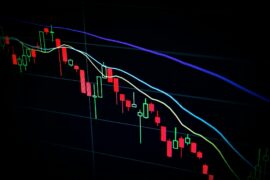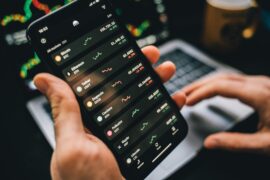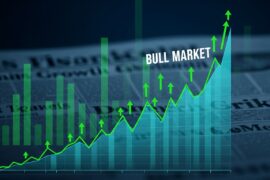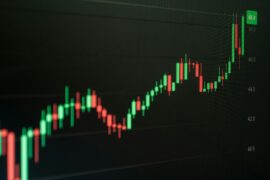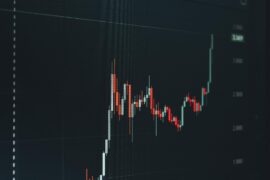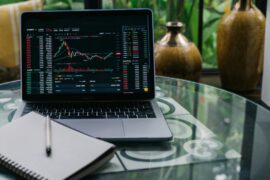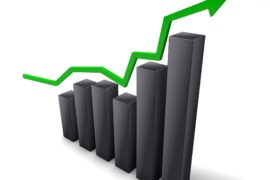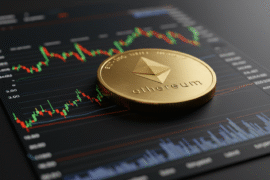This article may contain references to products or services from one or more of our advertisers or partners. We may receive compensation when you click on links to those products or services. Nonetheless, our opinions are our own.
The information presented in this article is accurate to the best of our knowledge at the time of publication. However, information is subject to change, and no guarantees are made about the continued accuracy or completeness of this content after its publication date.
- Market Uncertainty and How It Affects Your Finances
- The Current Market Uncertainty and Its Impact on Your Finances
- Indicators of Market Uncertainty and Their Sources
- How Inflation Trends Affect Your Spending Power
- The Role of Principal Federal Economic Indicators in Predicting Inflation
- Investment Strategies for Turbulent Times: Keeping Your Portfolio Balanced
- Supplemental Information & Additional Data for Making Informed Investment Decisions
- The Importance of Emergency Funds
- Tips for Staying Afloat Amid Market Volatility
- Future-Proofing Your Financial Plan
- Utilizing Benchmarking & Tools for Financial Planning
- The Conference Board Economic Forecast for the US Economy
- Frequently Asked Questions
- What factors are currently creating uncertainty in the US economy?
- How is uncertainty affecting the stock market?
- What sectors of the economy are most impacted by this uncertainty?
- How are consumers reacting to the economic uncertainty?
- What measures can policymakers take to address this uncertainty?
- What does the future hold for the US economy amidst this uncertainty?
- Recommended Reads
Market Uncertainty and How It Affects Your Finances
Recent signs point to potential challenges ahead for the U.S. economy. Investment plans are becoming more cautious, and consumer confidence is wavering. Global political tensions and shifting interest rates are interacting in ways that make the outlook difficult to predict. Knowing how these forces connect is essential for making sound decisions in today’s uncertain climate.
The Current Market Uncertainty and Its Impact on Your Finances
Right now, the markets feel highly unpredictable, and it’s understandable to worry about your financial future. Economic signals keep shifting, and the news often hints at possible slowdowns. This uncertainty can affect you directly, whether through job security, the value of your investments, or everyday expenses. In times like these, it helps to focus on a few core priorities:
Reevaluate Your Budget
Take the time to review your monthly expenses and adjust your budget to reflect any changes in your income or necessary expenditures. Look for areas where you can cut back.
Enhance Your Emergency Fund
In times of uncertainty, having a robust emergency fund can provide you with a safety net. Aim for at least three to six months’ worth of expenses saved up.
Diversify Your Investments
If you have investments, consider spreading them across different asset classes to reduce risk. Stocks, bonds, and real estate can all play a part in a balanced portfolio.
It is also important to stay informed without becoming overwhelmed. Here’s a quick outline of economic indicators to watch:
| Indicator | What It Reflects |
|---|---|
| Unemployment Rate | Health of the job market: rising unemployment may herald economic trouble. |
| Inflation Rate | How prices are changing; high inflation can erode purchasing power. |
| Consumer Confidence Index | Indicates how optimistic consumers are about the economy; higher confidence often leads to more spending. |
Monitoring these indicators and adjusting your financial strategies accordingly empowers you to effectively overcome market uncertainty. Remember, foresight and planning are your best allies during these unpredictable times.
Indicators of Market Uncertainty and Their Sources
Market Volatility
Sudden and drastic fluctuations in stock prices can signal investor anxiety, often triggered by unforeseen events such as geopolitical tensions or economic data releases.
Yield Curve Inversions
When short-term interest rates exceed long-term rates, it can foreshadow an economic downturn as investors lose confidence in future growth prospects.
Policy Decisions
Changes in monetary or fiscal policies by central banks or governments can create uncertainty about future economic conditions, influencing investor behavior and market dynamics.
How Inflation Trends Affect Your Spending Power
With inflation now a topic in debates about economic stability, it’s important to grasp how these changes affect your everyday finances. When prices climb, each dollar buys less, and goods or services you once purchased for less may now cost more. Here are some areas worth paying close attention to:
Grocery Costs
The prices of basic food items tend to climb, making it more vital than ever to manage your grocery budget effectively. Opting for seasonal produce and bulk buying can help you save.
Housing Expenses
Whether you’re renting or paying a mortgage, higher inflation can lead to increased costs associated with housing maintenance and rent hikes. It’s important to budget accordingly.
Transportation
Fuel prices are often affected by inflation, adding to your monthly expenses. Carpooling or using public transport can help mitigate these costs.
To better illustrate how inflation could impact your budget, consider the following table that outlines potential changes in costs over time:
| Item | Cost Last Year | Projected Cost This Year |
|---|---|---|
| Gallon of Milk | $3.50 | $4.00 |
| Rent (1-Bedroom Apt) | $1,250 | $1,350 |
| Gasoline (per gallon) | $2.90 | $3.50 |
Staying informed about these changes can empower you to make smarter financial decisions, ultimately helping you maintain your quality of life despite the challenges posed by a fluctuating economy. Be proactive in adjusting your budget to keep your financial goals within reach.
The Role of Principal Federal Economic Indicators in Predicting Inflation
The U.S. economy is made up of many connected forces that shape our everyday lives, especially our ability to spend. Inflation is one of the most influential, as it directly affects the cost of goods and services. From groceries to housing to transportation, its impact can be felt across nearly every part of a household budget. Staying aware of these changes helps us make smarter financial choices and adjust our spending when needed. As these shifts continue, knowing how federal economic indicators forecast inflation becomes increasingly important.
Voted "Best Overall Budgeting App" by Forbes and WSJ
Monarch Money helps you budget, track spending, set goals, and plan your financial future—all in one app.
Get 50% OFF your first year with code MONARCHVIP
Investment Strategies for Turbulent Times: Keeping Your Portfolio Balanced
In times of economic uncertainty, maintaining a balanced portfolio is more important than ever. Here are some strategies to guide you through the turbulent times:
Diversify Your Investments
Spread your investments across various asset classes: stocks, bonds, real estate, and even precious metals. This reduces risk, as different assets often behave differently in volatile markets.
Consider Defensive Stocks
Look for companies that provide goods and services, like utilities and consumer staples. These stocks tend to perform better during economic downturns, offering some stability to your portfolio.
Maintain a Cash Reserve
Having liquid assets on hand can give you the versatility to take advantage of sudden market opportunities or provide comfort during periods of volatility.
Regularly Rebalance
Make it a habit to review and adjust your portfolio periodically. This ensures that your investments remain in line with your risk tolerance and financial goals, helping you stay on track even when markets fluctuate.
Consider the following table for a quick comparison of asset classes to include in your portfolio:
| Asset Class | Risk Level | Potential Return |
|---|---|---|
| Stocks | High | 10%+ |
| Bonds | Medium | 4% – 6% |
| Real Estate | Medium | 5% – 8% |
| Cash | Low | 0% – 2% |
By implementing these strategies with a hands-on approach, you can strengthen your financial well-being and overcome any challenges that may arise.
Supplemental Information & Additional Data for Making Informed Investment Decisions
Supplementing your knowledge with additional data can help you make more informed decisions for your portfolio. Consider looking into economic indicators such as GDP growth, inflation rates, and unemployment figures to gauge the overall health of the economy. Moreover, staying abreast of global events and geopolitical developments can provide valuable insights into how different markets may be affected. Monitor changes in interest rates by central banks, as they can have varying effects on different asset classes.
The Importance of Emergency Funds
Having a financial safety net becomes more important than ever. An emergency fund isn’t just a passive savings account; it’s your buffer against the unknowns that can disrupt your financial stability, like job loss or unexpected medical expenses. Imagine accumulating savings equivalent to three to six months’ worth of living expenses, which enables you to overcome economic challenges without incurring debt. When uncertainty looms over the markets, this cushion provides peace of mind and the confidence to make informed decisions rather than rushed, emotional ones.
Building this fund can empower you to manage future challenges with resilience. Start by prioritizing your savings. Here are some practical steps you can take:
Set a Monthly Savings Goal
Even small contributions can add up over time.
Automate Transfers to Your Emergency Fund
This makes saving a seamless part of your routine.
Review and Adjust Your Budget
Look for discretionary expenses to cut back on, enhancing your savings potential.
To help visualize your progress, consider maintaining a simple tracker for your emergency fund. Here’s a quick snapshot you might find useful:
| Month | Amount Saved | Total Fund |
|---|---|---|
| January | $200 | $200 |
| February | $300 | $500 |
| March | $250 | $750 |
Having this financial strategy in place not only prepares you for unforeseen challenges but also strengthens your overall financial literacy. With a well-stocked emergency fund, you’re setting the foundation for a more secure financial future, no matter what economic ups and downs come your way.
Tips for Staying Afloat Amid Market Volatility
In times of market uncertainty, reassessing your budget can be a powerful way to maintain your financial stability. Start by reviewing your essentials and cutting back on non-essentials. Here are some practical tips to guide you:
Create a Buffer
Aim to set aside an emergency fund that covers 3–6 months of living expenses to safeguard against income disruptions.
Prioritize Spending
List your monthly expenses and categorize them into needs versus wants to ensure you’re focusing your resources effectively.
Negotiate Bills
Don’t hesitate to reach out to service providers and negotiate better terms or lower rates on utilities or subscriptions.
Additionally, consider revisiting your investment strategy. Market volatility can be daunting, but it’s needed to keep a long-term viewpoint. Here’s a simple table that outlines some adjustments to consider:
| Action | Considerations |
|---|---|
| Rebalance Portfolio | Adjust asset allocation to maintain your risk tolerance. |
| Invest in Stable Assets | Look for bonds or dividend-paying stocks to provide consistent returns. |
| Dollar-Cost Averaging | Invest a fixed amount periodically to mitigate the impact of volatility. |
These strategies can offer a clearer path through the financial fog, empowering you to make informed decisions and protect your future.
Future-Proofing Your Financial Plan
In an unpredictable economic climate, it’s needed to take proactive steps to ensure your financial plan holds up against uncertainties. Start by assessing your current financial situation. Make a list of your assets, liabilities, and ongoing expenses. This will give you a clearer picture of where you stand and what adjustments may be necessary. From there, consider diversifying your investment portfolio. Here are some options to explore:
- Stocks: With long-term growth potential, but be mindful of volatility.
- Bonds: Typically provide more stability, suitable for risk-averse investors.
- Real Estate: A tangible asset that can yield returns through rentals and appreciation.
- Precious Metals: Such as gold or silver, are often seen as a safeguard during economic downturns.
Additionally, prioritizing a robust emergency fund can safeguard you against unforeseen challenges. Ideally, aim for three to six months of living expenses saved. You may also want to revisit your retirement savings strategy to ensure you’re on track for your goals. Consider setting up or optimizing contributions to retirement accounts like an IRA or 401(k), where potential employer matching can give you an extra boost.
| Account Type | Contribution Limits (2025) | Employer Match |
|---|---|---|
| 401(k) | $23,500 | Up to 5% of salary |
| IRA | $7,000 | N/A |
Data from 401(K) Limit Increases to $23,500 for 2025, IRA Limit Remains $7,000 | Internal Revenue Service (n.d.)
Small, consistent efforts can lead to significant improvements in your financial security. Remember to periodically review and adjust your plan to accommodate life changes or shifts in economic conditions. The goal is to create a dynamic strategy that evolves with you.
Utilizing Benchmarking & Tools for Financial Planning
Assessing your financial situation is needed for a stable future. By knowing your assets, liabilities, and expenses, you can make informed decisions. Diversifying your investments is the trick. Stocks offer growth but come with volatility, bonds provide stability, real estate yields returns through rentals, and precious metals act as a hedge during downturns. Building an emergency fund is important for unexpected hurdles. Aim for 3–6 months of living expenses saved up. Review your retirement savings strategy regularly and maximize contributions to accounts like IRA or 401(k) to leverage potential employer matches.
The Conference Board Economic Forecast for the US Economy
The U.S. economy is constantly evolving, facing both opportunities and challenges that impact individuals and businesses alike. It’s important to prioritize building a solid financial foundation. One aspect is having an emergency fund in place to buffer against unforeseen circumstances. Experts suggest having at least three to six months’ worth of living expenses saved up for added security. Alongside this, optimizing your retirement savings strategy is necessary for long-term financial well-being.
Frequently Asked Questions

What factors are currently creating uncertainty in the US economy?
Several factors contribute to uncertainty in the US economy, including fluctuating interest rates, geopolitical tensions, and ongoing supply chain disruptions. Concerns about inflation and the potential for a recession are also making investors cautious.
How is uncertainty affecting the stock market?
Uncertainty in the economy tends to lead to increased volatility in the stock market. Investors may react by pulling back on investments or shifting their portfolios toward more stable assets. This has resulted in fluctuating stock prices as traders respond to changes in economic indicators and news events.
What sectors of the economy are most impacted by this uncertainty?
Industries such as technology, consumer goods, and energy are particularly vulnerable. Companies in these sectors may experience reduced consumer spending and investment, which can lead to slower growth or even contractions in these areas.
How are consumers reacting to the economic uncertainty?
Rising prices are pinching consumers, prompting them to adjust their spending habits. Many are prioritizing essentials and cutting back on discretionary purchases, which can further impact businesses and the overall economy.
What measures can policymakers take to address this uncertainty?
Policymakers can implement strategies such as monetary policy adjustments, stimulating investments, and supporting job creation to help stabilize the economy. Clear communication from the Federal Reserve and government leaders can also help restore confidence among investors and consumers.
What does the future hold for the US economy amidst this uncertainty?
While it’s challenging to predict the future, experts suggest that the economy could experience a slow recovery if underlying issues are addressed. Continued monitoring of economic indicators and proactive measures by both policymakers and businesses will be important in overcoming the uncertainty.

Reviewed and edited by Albert Fang.
See a typo or want to suggest an edit/revision to the content? Use the contact us form to provide feedback.
At FangWallet, we value editorial integrity and open collaboration in curating quality content for readers to enjoy. Much appreciated for the assist.
Did you like our article and find it insightful? We encourage sharing the article link with family and friends to benefit as well - better yet, sharing on social media. Thank you for the support! 🍉
Article Title: U.S. Economy at Risk Amid Market Fluctuations
https://fangwallet.com/2025/08/13/u-s-economy-at-risk-amid-market-fluctuations/The FangWallet Promise
FangWallet is an editorially independent resource - founded on breaking down challenging financial concepts for anyone to understand since 2014. While we adhere to editorial integrity, note that this post may contain references to products from our partners.
The FangWallet promise is always to have your best interest in mind and be transparent and honest about the financial picture.
Become an Insider

Subscribe to get a free daily budget planner printable to help get your money on track!
Make passive money the right way. No spam.
Editorial Disclaimer: The editorial content on this page is not provided by any of the companies mentioned. The opinions expressed here are the author's alone.
The content of this website is for informational purposes only and does not represent investment advice, or an offer or solicitation to buy or sell any security, investment, or product. Investors are encouraged to do their own due diligence, and, if necessary, consult professional advising before making any investment decisions. Investing involves a high degree of risk, and financial losses may occur including the potential loss of principal.
Source Citation References:
+ Inspo
401(k) limit increases to $23,500 for 2025, IRA limit remains $7,000 | Internal Revenue Service. (n.d.). https://www.irs.gov/newsroom/401k-limit-increases-to-23500-for-2025-ira-limit-remains-7000
















